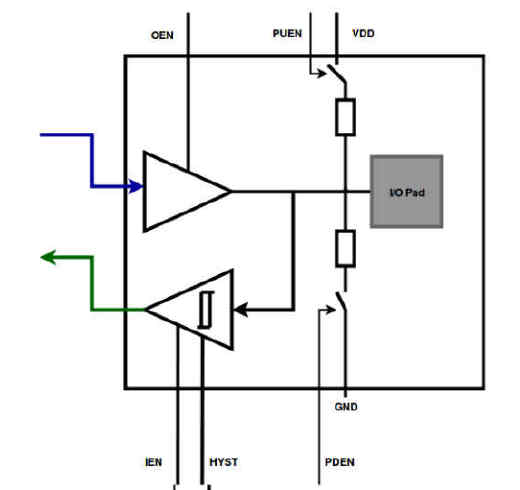IOcell

here is a list of requirements:
pull-up control which switches in a 10k (50k?) resistor
pull-down control which switches in a 10k (50k?) resistor
a "mode" setting that flips it between Open-Drain (floating if LO, and pulled to GND if HI) and CMOS (MOSFET) Push-Push modes. see https://en.wikipedia.org/wiki/Open_collector#MOSFET for details on Open Drain (requires a MOSFET).
a "hysteresis" setting that controls the input schottky filter's sensitivity. this is important for push-buttons for example, to stop spiking (bounce) that would be amplified and result in massive noise spikes onto all wires throughout that entire area of the chip. low middle and high settings are needed to cover filtering ranges of say 2mhz, 5mhz, 10mhz and unlimited (disabling hysteresis). looking at STM32F documentation helps here as does this https://electronics.stackexchange.com/questions/156930/stm32-understanding-gpio-settings
an input-enable selector
an output-enable selector
also required is a means to change the current output: 10mA, 20mA, 30mA and 40mA are reasonable
also the input and output really need automatic level-shifting, built-in to the IO cell. so whilst there is a VDD for driving the pad (and setting the CMOS threshold levels for input), there is also a need for an IO VREF. this is important. the input and output needs to be CMOS push-push (standard logic) whilst the IO pad needs to be switchable between OD and PP.
input threshold voltages that trigger the input from HI to LO should be standard CMOS voltage levels (even in OD mode), which i believe is below 0.3 * VDD for "LO" and 0.7 * VDD for "HI"
output voltage levels should be as close to 0 as possible for LO (0.3v or below @ nominal temperature) and as close to VDD as possible for HI (VDD-0.3v or above @ nominal temperature).
some ability to protect itself from over-driving (current fights) when in output mode are a must.
the ability to protect itself from being over-driven when in input mode is not strictly necessary (over-voltage tolerance e.g. 5V tolerance when VDD is well below that) but would be nice to have as an option (two variants: one for ECs which need 5V tolerance and one for SoCs where it's not).